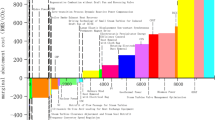Abstract
In this paper, we analyze the relative importance and mutual behavior of two competing base-load electricity generation options that each are capable of contributing significantly to the abatement of global CO2 emissions: nuclear energy and coal-based power production complemented with CO2 capture and storage (CCS). We also investigate how, in scenarios developed with an integrated assessment model that simulates the economics of a climate-constrained world, the prospects for nuclear energy would change if exogenous limitations on the spread of nuclear technology were relaxed. Using the climate change economics model World Induced Technical Change Hybrid, we find that until 2050 the growth rates of nuclear electricity generation capacity would become comparable to historical rates observed during the 1980s. Given that nuclear energy continues to face serious challenges and contention, we inspect how extensive the improvements of coal-based power equipped with CCS technology would need to be if our economic optimization model is to significantly scale down the construction of new nuclear power plants.






Similar content being viewed by others
Notes
More recently, some modeling assumptions fed into the MIT scenarios were revised: Nuclear power is now projected to increase more rapidly than in previous studies (see [13]).
For more details, see, e.g., Bosetti et al. [1] and the model’s website at http://www.witchmodel.org.
The half time of atmospheric CO2 is roughly 100 years, and the lifetime of a power plant can surpass half a century.
A higher CO2 capture rate or the use of CCS in conjunction with biomass would allow CCS to remain competitive in a stringent climate scenario beyond 2050.
This could be achieved either by improving CO2 capture technology or by co-firing coal with biomass.
References
Bosetti, V., Carraro, C., Galeotti, M., Massetti, E., & Tavoni, M. (2006). WITCH: A World Induced Technical Change Hybrid Model. The Energy Journal, Special Issue on “Hybrid Modelling of Energy Environment Policies: Reconciling Bottom-up and Top-down”, 13–38.
Bosetti, V., Carraro, C., Massetti, E., Sgobbi, A., & Tavoni, M. (2009). Optimal energy investment and R&D strategies to stabilise greenhouse gas atmospheric concentrations. Resource and Energy Economics, 31–2, 123–137.
Bunn, M., Fetter, S., Holdren, J. P., & van der Zwaan, B. C. C. (2005). The economics of reprocessing vs. direct disposal of spent nuclear fuel. Nuclear Technology, 150, 209–230.
Chakravorty, U., Magne, B., & Moreaux, M. (2005). Can nuclear power solve the global warming problem? Available at SSRN: http://ssrn.com/abstract=781245.
Clarke, L., Edmonds, J., Jacoby, H., Pitcher, H., Reilly, J., & Richels, R. (2007). Scenarios of greenhouse gas emissions and atmospheric concentrations. Sub-report 2.1A of synthesis and assessment product 2.1 by the U.S. Climate Change Science Program and the Subcommittee on Global Change Research. Washington, DC.: Department of Energy, Office of Biological & Environmental Research. 154 pp.
Ferioli, F., Schoots, K., & van der Zwaan, B. C. C. (2009). Use and limitations of learning curves for energy technology policy: A component-learning hypothesis. Energy Policy, 37, 2525–2535.
Hendriks, C., Graus, W., & Bergen, F. V. (2002). Global carbon dioxide storage potential costs. Report EEP 02001. Utrecht: Ecofys.
IEA. (2000). Experience curves for energy technology policy. Paris: OECD/IEA.
IEA. (2008). Energy technology perspectives 2008. Paris: OECD/IEA.
IPCC, Intergovernmental Panel on Climate Change, Climate Change. (2007). Working group III report “Mitigation of climate change”. Cambridge: Cambridge University Press.
IPFM, International Panel on Fissile Materials. (2007). Global fissile material report 2007. Second report of the IPFM. Princeton: Princeton University.
MIT. (2003). The future of nuclear power: an interdisciplinary MIT study. Cambridge: Massachusetts Institute of Technology.
Paltsev, S., Reilly, J. M., Jacoby, H. D., & Morris, J. F. (2009). “The cost of climate policy in the United States” MIT’s Joint Program on the Science and Policy of Global Change, Report 173.
Rogner, H.-H., Sharma, D., & Jalal, A. I. (2008). Nuclear power versus fossil-fuel power with CO2 capture and storage: A comparative analysis. International Journal of Energy Sector Management, 2(2), 181–196.
Sailor, W. C., Bodansky, D., Braun, C., Fetter, S., & van der Zwaan, B. C. C. (2000). A nuclear solution to climate change? Science, 288, 1177–1178.
Toth, F. L., & Rogner, H.-H. (2006). Oil and nuclear power: Past, present, and future. Energy Economics, 28, 1–25.
Vaillancourt, K., Labriet, M., Loulou, R., & Waaub, J. P. (2008). The role of nuclear energy in long-term climate scenarios: An analysis with the World-TIMES model. Energy Policy, 36(7), 2296–2307.
van der Zwaan, B. C. C. (2002). Nuclear energy: Tenfold expansion or phaseout? Technological Forecasting and Social Change, 69, 287–307.
van der Zwaan, B. C. C. (2008). Prospects for nuclear energy in Europe. International Journal of Global Energy Issues, 30(1/2/3/4), 102–121.
Weisser, D., Howells, M., & Rogner, H.-H. (2008). Nuclear power and post-2012 energy and climate change policies. Environmental Science & Policy, 11, 467–477.
Author information
Authors and Affiliations
Corresponding author
Additional information
This paper is a contribution to the project “PLANETS,” funded by the European Commission under the seventh framework program.
Rights and permissions
About this article
Cite this article
Tavoni, M., van der Zwaan, B. Nuclear Versus Coal plus CCS: a Comparison of Two Competitive Base-Load Climate Control Options. Environ Model Assess 16, 431–440 (2011). https://doi.org/10.1007/s10666-011-9259-1
Received:
Accepted:
Published:
Issue Date:
DOI: https://doi.org/10.1007/s10666-011-9259-1




